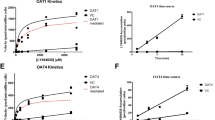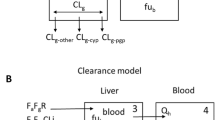Abstract
Background and Objectives
The Extended Clearance Classification System (ECCS) was established to facilitate the timely anticipation of clearance rate determination according to the physicochemical characteristics of a given compound and in vitro passive membrane permeability. Unfortunately, distinguishing between renal and hepatic uptake clearance mechanisms using ECCS class 3B is not possible. We determined the effects of plasma protein binding (PPB) on major hepatic organic anion transporting polypeptide (OATP) and renal organic anion transporter (OAT) substrates. A modified ECCS could predict when renal or hepatic uptake mechanisms were the main clearance rate determinants (accounting for ≥ 70% of total clearance).
Methods
A dataset of 66 human OATP and 41 OAT substrates was analyzed to determine the effect of PPB. A total of 63 acidic and zwitterionic, and high-molecular-weight (MW > 400 Da) compounds, including 50 drugs in ECCS classes 1B and 3B, were reanalyzed considering their PPB.
Results
Statistical analyses revealed that hepatic uptake transporter (OATP1B1 and OATP1B3) substrates possess a high PPB rate of ≥ 90%, whereas OAT1 and/or OAT3 substrates possess low PPB rates of < 90%. By analyzing the 63 drugs on the basis of their PPB, the active hepatic uptakes of acids and zwitterions were determined to be the main clearance mechanisms, with PPB ≥ 90%, whereas renally eliminated drugs exhibited limited PPB (< 90%).
Conclusions
Therefore, PPB is an effective parameter for defining clearance rate determination for acidic and zwitterionic drugs with high MWs. Using PPB as an additional parameter in ECCS, clearance mechanisms for class 1B and 3B compounds can be predicted, and OATP and OAT substrates may be readily distinguished.




Similar content being viewed by others
References
Grime K, Paine SW. Species differences in biliary clearance and possible relevance of hepatic uptake and efflux transporters involvement. Drug Metab Dispos. 2013;41(2):372–8. https://doi.org/10.1124/dmd.112.049312.
Ghibellini G, Leslie EM, Brouwer KL. Methods to evaluate biliary excretion of drugs in humans: an updated review. Mol Pharm. 2006;3(3):198–211. https://doi.org/10.1021/mp060011k.
Yang X, Gandhi YA, Duignan DB, Morris ME. Prediction of biliary excretion in rats and humans using molecular weight and quantitative structure–pharmacokinetic relationships. AAPS J. 2009;11(3):511–25. https://doi.org/10.1208/s12248-009-9124-1.
Varma MV, Chang G, Lai Y, Feng B, El-Kattan AF, Litchfield J, et al. Physicochemical property space of hepatobiliary transport and computational models for predicting rat biliary excretion. Drug Metab Dispos. 2012;40(8):1527–37. https://doi.org/10.1124/dmd.112.044628.
Varma MV, Steyn SJ, Allerton C, El-Kattan AF. Predicting clearance mechanism in drug discovery: extended clearance classification system (ECCS). Pharm Res. 2015;32(12):3785–802. https://doi.org/10.1007/s11095-015-1749-4.
Fasano M, Curry S, Terreno E, Galliano M, Fanali G, Narciso P, et al. The extraordinary ligand binding properties of human serum albumin. IUBMB Life. 2005;57(12):787–96. https://doi.org/10.1080/15216540500404093.
Wanat K. Biological barriers, and the influence of protein binding on the passage of drugs across them. Mol Biol Rep. 2020;47(4):3221–31. https://doi.org/10.1007/s11033-020-05361-2.
Obach RS, Lombardo F, Waters NJ. Trend analysis of a database of intravenous pharmacokinetic parameters in humans for 670 drug compounds. Drug Metab Dispos. 2008;36(7):1385–405. https://doi.org/10.1124/dmd.108.020479.
Odović JV, Sakač MAC, Vujić ZB. The correlation of plasma protein binding and molecular properties of selected antifungal drugs. J Serb Chem Soc. 2020;85(7):897–907. https://doi.org/10.2298/JSC190925125O.
Kim S-J, Lee K-R, Miyauchi S, Sugiyama Y. Extrapolation of in vivo hepatic clearance from in vitro uptake clearance by suspended human hepatocytes for anionic drugs with high binding to human albumin: improvement of in vitro-to-in vivo extrapolation by considering the “albumin-mediated” hepatic uptake mechanism on the basis of the “facilitated-dissociation model.” Drug Metab Dispos. 2019;47(2):94–103. https://doi.org/10.1124/dmd.118.083733.
Bowman CM, Okochi H, Benet LZ. The presence of a transporter-induced protein binding shift: a new explanation for protein-facilitated uptake and improvement for in vitro–in vivo extrapolation. Drug Metab Dispos. 2019;47(4):358–63. https://doi.org/10.1124/dmd.118.085779.
Miyauchi S, Masuda M, Kim S-J, Tanaka Y, Lee K-R, Iwakado S, et al. The phenomenon of albumin-mediated hepatic uptake of organic anion transport polypeptide substrates: prediction of the in vivo uptake clearance from the in vitro uptake by isolated hepatocytes using a facilitated-dissociation model. Drug Metab Dispos. 2018;46(3):259–67. https://doi.org/10.1124/dmd.117.077115.
Fukuchi Y, Toshimoto K, Mori T, Kakimoto K, Tobe Y, Sawada T, et al. Analysis of nonlinear pharmacokinetics of a highly albumin-bound compound: contribution of albumin-mediated hepatic uptake mechanism. J Pharm Sci. 2017;106(9):2704–14. https://doi.org/10.1016/j.xphs.2017.04.052.
Yamashiro W, Maeda K, Hirouchi M, Adachi Y, Hu Z, Sugiyama Y. Involvement of transporters in the hepatic uptake and biliary excretion of valsartan, a selective antagonist of the angiotensin II AT1-receptor, in humans. Drug Metab Dispos. 2006;34(7):1247–54. https://doi.org/10.1124/dmd.105.008938.
Johnson-Davis KL, Dasgupta A. Special issues in therapeutic drug monitoring in patients with uremia, liver disease, and in critically ill patients. In: Clinical challenges in therapeutic drug monitoring. New York: Elsevier; 2016. p. 245–60. https://doi.org/10.1016/B978-0-12-802025-8.00011-8.
Li Y-F, Zhang X-Q, Hu W-Y, Li Z, Liu P-X, Zhang Z-Q. Rapid screening of drug-protein binding using high-performance affinity chromatography with columns containing immobilized human serum albumin. J Anal Methods Chem. 2013. https://doi.org/10.1155/2013/439039.
https://www.drugbank.ca/. Accessed 16 Oct 2022.
Varma M, Kimoto E, Scialis R, Bi Y, Lin J, Eng H, et al. Transporter-mediated hepatic uptake plays an important role in the pharmacokinetics and drug-drug interactions of montelukast. Clin Pharmacol Ther. 2017;101(3):406–15. https://doi.org/10.1002/cpt.520.
Bow DA, Perry JL, Simon JD, Pritchard JB. The impact of plasma protein binding on the renal transport of organic anions. J Pharmacol Exp Ther. 2006;316(1):349–55. https://doi.org/10.1124/jpet.105.093070.
Benet LZ, Hoener BA. Changes in plasma protein binding have little clinical relevance. Clin Pharmacol Ther. 2002;71(3):115–21. https://doi.org/10.1067/mcp.2002.121829.
Kalliokoski A, Niemi M. Impact of OATP transporters on pharmacokinetics. Br J Pharmacol. 2009;158(3):693–705. https://doi.org/10.1124/dmd.105.008938.
Nozawa T, Minami H, Sugiura S, Tsuji A, Tamai I. Role of organic anion transporter OATP1B1 (OATP-C) in hepatic uptake of irinotecan and its active metabolite, 7-ethyl-10-hydroxycamptothecin: in vitro evidence and effect of single nucleotide polymorphisms. Drug Metab Dispos. 2005;33(3):434–9. https://doi.org/10.1124/dmd.104.001909.
Cvetkovic M, Leake B, Fromm MF, Wilkinson GR, Kim RB. OATP and P-glycoprotein transporters mediate the cellular uptake and excretion of fexofenadine. Drug Metab Dispos. 1999;27(8):866–71.
Khurana V, Minocha M, Pal D, Mitra AK. Role of OATP-1B1 and/or OATP-1B3 in hepatic disposition of tyrosine kinase inhibitors. Drug Metab Drug Interact. 2014;29(3):179–90. https://doi.org/10.1515/dmdi-2013-0062.
Maeda K. Organic anion transporting polypeptide (OATP) 1B1 and OATP1B3 as important regulators of the pharmacokinetics of substrate drugs. Biol Pharm Bull. 2015;38(2):155–68. https://doi.org/10.1248/bpb.b14-00767.
Smith DA, Di L, Kerns EH. The effect of plasma protein binding on in vivo efficacy: misconceptions in drug discovery. Nat Rev Drug Discov. 2010;9(12):929–39. https://doi.org/10.1038/nrd3287.
Baker KJ, Bradley SE. Binding of sulfobromophthalein (BSP) sodium by plasma albumin. Its role in hepatic BSP extraction. J Clin Investig. 1966;45(2):281–7.
Bteich M, Poulin P, Haddad S. The potential protein-mediated hepatic uptake: discussion on the molecular interactions between albumin and the hepatocyte cell surface and their implications for the in vitro-to-in vivo extrapolations of hepatic clearance of drugs. Expert Opin Drug Metab Toxicol. 2019;15(8):633–58. https://doi.org/10.1080/17425255.2019.1640679.
Krause S, Ulrich N, Goss K-U. Desorption kinetics of organic chemicals from albumin. Arch Toxicol. 2018;92(3):1065–74. https://doi.org/10.1007/s00204-017-2117-4.
Bowman CM, Chen E, Chen L, Chen Y-C, Liang X, Wright M, et al. Changes in organic anion transporting polypeptide uptake in HEK293 overexpressing cells in the presence and absence of human plasma. Drug Metab Dispos. 2020;48(1):18–24.
Francis LJ, Houston J, Hallifax D. Impact of plasma protein binding in drug clearance prediction: a data base analysis of published studies and implications for in vitro–in vivo extrapolation. Drug Metab Dispos. 2021;49(3):188–201. https://doi.org/10.1124/dmd.120.000294.
Wu CY, Benet LZ. Predicting drug disposition via application of BCS: transport/absorption/elimination interplay and development of a biopharmaceutics drug disposition classification system. Pharm Res. 2005;22(1):11–23.
Varma M, El-Kattan A, Feng B, Steyn S, Maurer T, Scott D, et al. Extended clearance classification system (ECCS) informed approach for evaluating investigational drugs as substrates of drug transporters. Clin Pharmacol Ther. 2017;102(1):33–6.
Kimoto E, Mathialagan S, Tylaska L, Niosi M, Lin J, Carlo AA, et al. Organic anion transporter 2–mediated hepatic uptake contributes to the clearance of high-permeability–low-molecular-weight acid and zwitterion drugs: evaluation using 25 drugs. J Pharmacol Exp Ther. 2018;367(2):322–34. https://doi.org/10.1124/jpet.118.252049.
Benet LZ, Broccatelli F, Oprea TI. BDDCS applied to over 900 drugs. AAPS J. 2011;13(4):519–47. https://doi.org/10.1208/s12248-011-9290-9.
Lepist E-I, Zhang X, Hao J, Huang J, Kosaka A, Birkus G, et al. Contribution of the organic anion transporter OAT2 to the renal active tubular secretion of creatinine and mechanism for serum creatinine elevations caused by cobicistat. Kidney Int. 2014;86(2):350–7.
Fang Z, Huang J, Chen J, Xu S, Xiang Z, Hong M. Transmembrane domain 1 of human organic anion transporting polypeptide 2B1 is essential for transporter function and stability. Mol Pharmacol. 2018;94(2):842–9. https://doi.org/10.1124/mol.118.111914.
Shen H, Lai Y, Rodrigues AD. Organic anion transporter 2: an enigmatic human solute carrier. Drug Metab Dispos. 2017;45(2):228–36. https://doi.org/10.1124/dmd.116.072264.
Acknowledgements
We would like to thank Editage (www.editage.com) for English language editing.
Author information
Authors and Affiliations
Corresponding author
Ethics declarations
Authors Contributions
Y.K. and F.H. made substantial contributions to the conception of the work as well as analysis and interpretation of data, drafted the work, and revised it critically for important intellectual content. H.H. supervised the work, approved the version to be published, and agrees to be accountable for all aspects of the work in ensuring that questions related to the accuracy or integrity of any part of the work are appropriately investigated and resolved.
Funding
No funding was used to conduct this study.
Availability of Data and Materials
All data generated or analyzed during this study are included in this published article and its supplementary information files.
Code Availability
Not applicable.
Conflict of interest
Yahya Khawaja, Fatma Haddad, and Hussein Hallak declare that they have no conflicts of interest.
Ethics approval
Not applicable.
Consent to participate
Not applicable.
Consent for publication
Not applicable.
Supplementary Information
Below is the link to the electronic supplementary material.
Rights and permissions
Springer Nature or its licensor (e.g. a society or other partner) holds exclusive rights to this article under a publishing agreement with the author(s) or other rightsholder(s); author self-archiving of the accepted manuscript version of this article is solely governed by the terms of such publishing agreement and applicable law.
About this article
Cite this article
Khawaja, Y., Haddad, F. & Hallak, H. Plasma Protein Binding Refinement of the Extended Clearance Classification System: Subclasses for Predicting Hepatic Uptake or Renal Clearance for Classes 1B and 3B. Eur J Drug Metab Pharmacokinet 48, 63–73 (2023). https://doi.org/10.1007/s13318-022-00806-4
Accepted:
Published:
Issue Date:
DOI: https://doi.org/10.1007/s13318-022-00806-4




